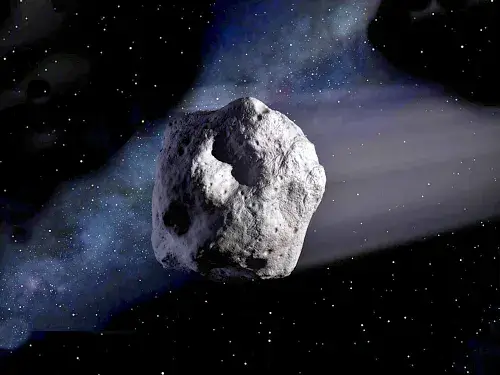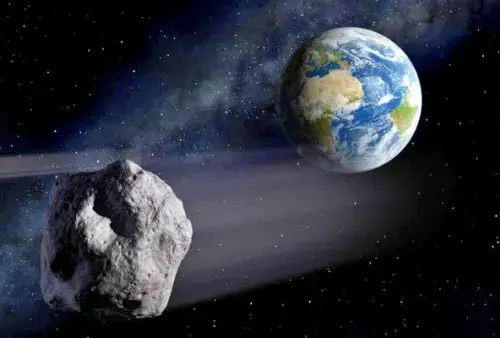My Space. Imagine a celestial ballet, an intricate dance of cosmic bodies swirling around our Sun. Within this grand performance, a particular group of performers holds our rapt attention: Near-Earth Objects (NEOs).
These aren’t just any space rocks; they’re asteroids and comets whose orbits bring them within approximately 45 million kilometers of Earth.
Their sizes vary dramatically, from mere meters across to colossal giants, like the largest known NEO, 1036 Ganymed, which stretches a staggering 41 kilometers in diameter.
While over 10,000 such objects have been discovered, some passing by our planet without incident, the true allure and potential threat lie in the ones we haven’t yet found.
My Space, the Big Ones.
A Kilometre and Beyond.
Of the more than 10,000 NEOs identified to date, roughly 10% are a kilometer or larger in size. Why is this significant?
Because objects of this magnitude, should they collide with Earth, have the potential to trigger truly catastrophic, and undeniably “interesting,” consequences.
The sheer energy released by such an impact could lead to widespread devastation, altering our planet’s climate and ecosystems on a global scale. This is not a scenario to be taken lightly, and it’s why the dedicated efforts to track these cosmic wanderers are so vital.
The good news, as emphasized by NASA’s Near-Earth Object Observations (NEOO) Program, is that none of the currently identified kilometer-sized objects pose an immediate threat to Earth.
In fact, a remarkable 98% of all known NEOs have been cataloged under NASA’s comprehensive programs. This impressive achievement is a testament to the dedication of scientists and the power of modern astronomical observation.
A Century of Discovery.
From a Trickle to a Torrent.
The journey of NEO discovery began in 1898 with the identification of the very first near-Earth object. For the next century, progress was slow, with only about 500 such objects being found.
However, the advent of the NEO Observations program marked a pivotal moment, shattering previous limitations. We’ve literally broken the discovery barrier.
Today, more efficient detection systems are in operation, allowing us to meticulously track the present and future positions of NEOs within our solar system.
The discovery of the 10,000th near-Earth object was a significant milestone, a testament to the accelerating pace of our understanding of our cosmic neighborhood.
Yet, despite this achievement, an estimated ten times more objects still await discovery before we can truly rest assured that no unforeseen impactor lurks in the shadows, ready to bring harm to Earth’s inhabitants.
Consider asteroid 2013 MZ5, a respectable 300 meters in diameter. Its orbit is well-defined and understood, confirming that it will not approach Earth closely enough to pose a danger.
While many intriguing meteorites have impacted Earth throughout its long history, the vast majority of NEOs are smaller than a kilometer. The smaller the size, the more numerous they become.
For instance, it’s estimated that there are approximately fifteen thousand objects about half the size of a football field (140 meters), and over a million objects roughly a third the size of a football field (30 meters).
For a NEO to cause significant damage in a populated area, it generally needs to be 30 meters or larger.
While about 30% of 140-meter objects have already been found, less than 1% of the 30-meter NEOs have been registered. This highlights the immense task still at hand.
The Pursuit of 90%.
A Shield Against the Unknown.
Over the past decade, NASA’s NEOO program has achieved a monumental goal: identifying and registering 99% of all near-Earth objects one kilometer or larger in diameter.
When this ambitious goal is met, the risk of an unexpected future impact from such an object will be reduced to a mere 1%.
This ongoing endeavor is a testament to humanity’s proactive approach to cosmic threats. The good news is that with current technologies, any detected NEO could, in principle, be deflected well in advance.
The key, then, is to detect them in time. This is where the efforts of initiatives like the Catalina Sky Survey, Pan-STARRS, and LINEAR come into play, contributing to the current rate of 1,000 new NEO discoveries per year.
Beyond Threat Assessment.
Unlocking Cosmic Secrets.
The study of NEOs extends far beyond mere threat assessment. Missions like OSIRIS-REx to asteroid Bennu (101955) are paving the way for future spacecraft that will observe and analyze objects yet to be discovered.
These missions aren’t just about identifying potential impactors; they offer an unparalleled opportunity to delve into the very origins of our solar system, to understand how water arrived on Earth, and even to uncover the genesis of the organic molecules that ultimately led to the development of life itself.
These cosmic wanderers hold clues to our deep past and the very fabric of existence.
NASA’s WISE mission, for example, successfully identified a family of asteroids that may be responsible for the demise of the dinosaurs. This remains one of Earth’s greatest enigmas, a colossal “cold case” from prehistory.
Scientists are confident that a massive asteroid impact approximately 65 million years ago led to the extinction of dinosaurs and many other life forms on our planet.
However, the precise origin and trajectory of that fateful asteroid have long been a subject of intense scientific debate. A 2007 study, leveraging data from ground-based telescopes, initially suggested that a colossal asteroid named Baptistina might be the culprit.
The Baptistina Hypothesis.
A Cosmic Alibi.
According to the initial Baptistina theory, this enormous asteroid collided with another asteroid in the main belt between Mars and Jupiter around 160 million years ago.
This titanic collision was believed to have spawned a multitude of fragments, some as large as mountains. One of these rocky shards, so the theory went, hurtled towards Earth, sealing the dinosaurs’ fate.
When this scenario was first proposed, evidence was developed that supported the involvement of the Baptistina asteroid family in the catastrophe. However, new observations from the WISE mission have allowed astronomers to confidently rule out Baptistina as a suspect.
This cosmic alibi means the search for the true culprit continues, underscoring the dynamic nature of scientific discovery and the constant refinement of our understanding.
Each new piece of data brings us closer to unraveling these ancient cosmic mysteries.
The ongoing vigilance, coupled with the insatiable quest for knowledge about our universe, ensures that we are not only protecting our planet from potential threats but also continuously expanding the horizons of human understanding.
What other secrets do these silent sentinels hold?
Have a Great Day!
Just:
** Scientists say that the most dangerous asteroid ever observed for humanity, “2024YR4”, which was initially considered a potential threat to Earth, will not hit our planet. However, there is a relatively high probability that it could hit the Moon.
“2024 YR4” will hit the Moon in December 2032
** 3I/ATLAS. In November 2025, Earth could encounter something truly unexpected and possibly hostile. Scientists have registered a huge interstellar object in space, larger than Manhattan and, according to some hypotheses, could be an alien ship.
According to the New York Post, it is a celestial body with the code name 3I/ATLAS, which was discovered on July 1, 2025. It is rushing towards the Sun at a speed exceeding 200 thousand kilometers per hour, and, according to some astrophysicists, it may not just be a comet, but an artificial object – a technological probe sent by an extraterrestrial civilization.





